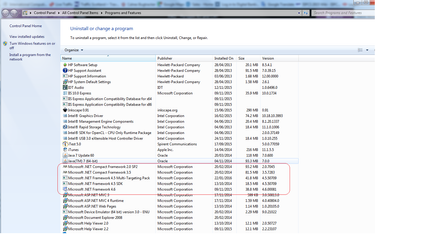Standalone CAT/PFV: .NET and PC Configuration
Problem
You are using the stand-alone version of the CAT or PFV (not the version installed on Paragon-100G or Paragon-neo) and you see one of the following issues:
- CAT or PFV fails to start and gets stuck at 10%
- Report generation does not work or generated reports contain no images
Solution
Check you have to correct versions of .NET installed
Verify the versions of .NET that you have installed on your PC. Both version 3.5 and version 4.5 (or later) must be installed.
The full version of .NET 4.5 (or later) must be installed. Note that the Client profile and Extension packages are not the full framework. If, in your Programs list, you see something similar to below, then this is NOT the full .NET version and is insufficient to run the CAT:
.NET Framework 4 Client profile
.NET Framework 4 Extension
In some cases, version 3.5 needs to be enabled. This may not be the default for a Windows installation.
You can check the installed versions using Control Panel→Programs and Features (or the equivalent):
To check if .NET Framework 3.5 is enabled use the Turn Windows Features on or off selection in this window. This will launch the Server Manager dialogue. Scroll down to the Features Summary and select Add Features. In the Add Features Wizard make sure that the .Net Framework 3.0 box is ticked.
Delete the CAT Settings File
If all of the above looks OK, then try deleting the CAT settings file. This has been found to get corrupted occasionally and, if this happens, it can prevent the CAT from starting up properly. Go to Documents/Calnex/CAT/Settings and delete cat.default.cps.
Note that this is a settings file - the users settings will be lost but there are no other side-effects; the file will be re-created once the CAT is running.
Check your Firewall and Proxy Settings
From version 15.00 onwards, the CAT is based on a client-server model. The client communicates with the server over TCPIP using localhost port 1337.
The PC firewall must be configured such that communication between the client and server is not blocked. When the CAT is initially installed and run, the user will normally be asked if they want to allow communication or not - allowing this communication should then configure their firewall correctly.
If your LAN connection is through a proxy server, the PC should be set up to bypass the proxy server for local addresses. This will allow direct localhost connections with no proxy involvement. To bypass the proxy, go to Control Panel and select Internet Options. From the Connections tab click Lan Settings. In the dialogue box, make sure that Bypass proxy server for local addresses is checked.
Advanced Trouble-Shooting
If none of the above helps, then you need to do some debugging:
- Run the CAT and leave it at the Initialising step for a few minutes. Start a standard browser (e.g. IE, Chrome, Firefox) and then connect to http://127.0.0.1:1337.
- If this doesn't work, then collect the CAT log files – zip up the folder C:\Users\<user>\Documents\Calnex\Cat\Logs – then raise a Service Request and attach the logs to the ticket.
- If (1) works, then try connecting to http://localhost:1337.
- If (2) doesn't work, then edit the host file (as shown below) and try again.
- If still things aren't working, then raise a Service Request and attach the logs (see above) to the ticket.
If 127.0.0.1 works but localhost doesn't, then this would indicate a problem in the DNS set up. It is possible that the hosts file is set up incorrectly. In this case you have to run Notepad as Administrator then open file "C:\Windows\System32\drivers\etc\hosts" and make sure there is an entry that looks like this:
127.0.0.1 localhost
If there is an entry like
:: localhost or ::1 localhost
Comment it out with a # character:
#:: localhost
#::1 localhost
Then add:
127.0.0.1 localhost
This should fix any problem with localhost mapping.
Related articles

